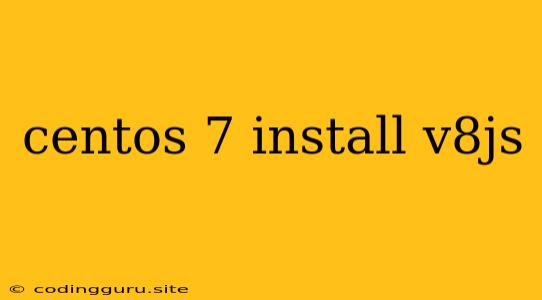Installing V8 JavaScript Engine on CentOS 7
The V8 JavaScript engine is a powerful tool for developers working with JavaScript, providing high performance and efficient execution of JavaScript code. If you're working on a CentOS 7 system, you might need to install V8 to leverage its capabilities. This guide will walk you through the installation process step-by-step.
Why Use V8 on CentOS 7?
V8 is a key component in various technologies like Node.js, Chrome, and Chromium, making it a valuable asset for development. Here are some key reasons why you might want to install V8 on your CentOS 7 system:
- Increased JavaScript execution speed: V8 is renowned for its high performance and ability to execute JavaScript code efficiently. This can significantly improve the performance of your applications.
- Integration with Node.js: If you're using Node.js on your CentOS 7 system, V8 is the engine that powers its JavaScript execution. Installing V8 ensures compatibility and optimal performance for Node.js applications.
- Chrome/Chromium development: If you're developing extensions or web apps for Chrome or Chromium, having V8 installed on your development environment is crucial.
Prerequisites
Before you start the installation process, ensure your CentOS 7 system meets the following prerequisites:
- Internet connection: You'll need an active internet connection to download the required packages.
- Root or administrator privileges: You'll need to use
sudoor log in as root to perform the installation.
Installation Steps
Follow these steps to install V8 on your CentOS 7 system:
-
Update your system:
sudo yum update -
Install the necessary dependencies:
sudo yum install gcc g++ make autoconf libtool -
Download the V8 source code: You can download the latest stable version of V8 from the official website. Alternatively, you can use
wgetto download the source code directly from the command line:wget https://github.com/v8/v8/archive/refs/heads/main.zip -
Extract the downloaded archive:
unzip main.zip -
Configure V8 for your system: Navigate to the extracted directory and configure V8:
cd v8-main ./configure -
Build and install V8:
make sudo make install -
Verify the installation: To ensure V8 was installed correctly, you can check the version using the
v8command:v8 --version
Example Usage
After successful installation, you can use the v8 command to run JavaScript code directly:
echo 'console.log("Hello from V8!");' | v8
This will output "Hello from V8!" to your console.
Conclusion
Installing V8 on your CentOS 7 system is a straightforward process. By following these steps, you can leverage the power and efficiency of the V8 JavaScript engine for your development projects. Remember to keep your system updated and refer to the official V8 documentation for the latest information and advanced usage techniques.
